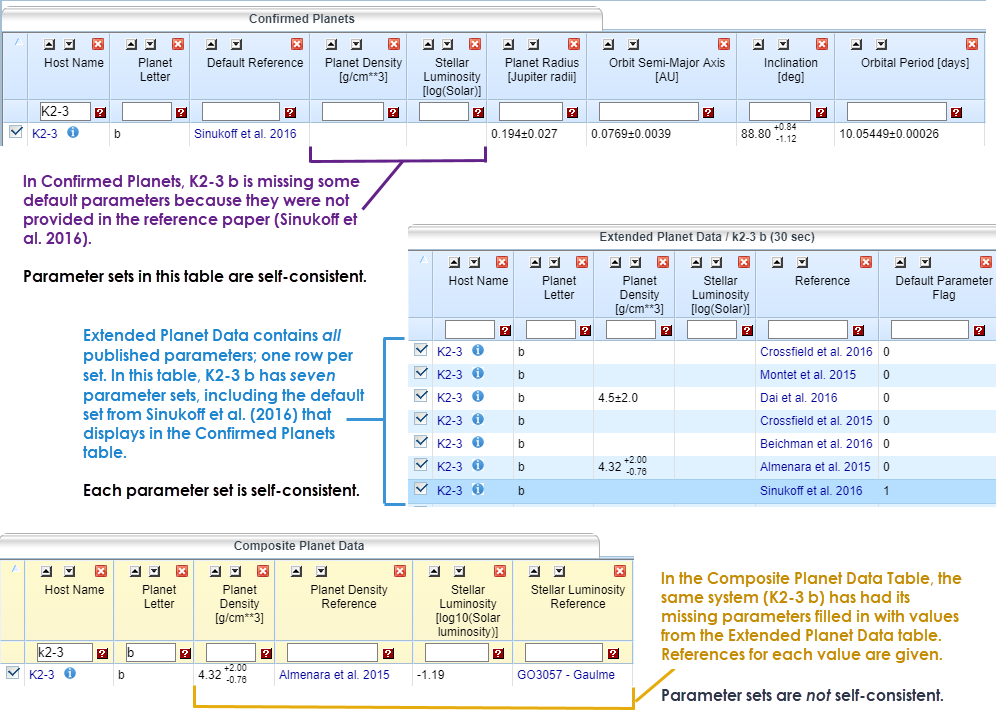This table has been retired and is no longer being updated. Please use the Planetary Systems (PS) or Planetary System Composite Parameters (PSCompPars) Tables for the most current data, and refer to the documentation for data column definitions. More details about the retired and new tables are in the Developing a More Integrated NASA Exoplanet Archive page.
About the Composite Planet Data Table
The Composite Planet Data table ("Composite table") is a compilation of stellar and planetary parameters for known Confirmed Exoplanets. The purpose of this table is to enable a more statistical view of the known exoplanet population and their host environments.
The NASA Exoplanet Archive collects and maintains many sets of parameters for planets, planetary orbits, and host systems as they are published in the refereed literature. The Confirmed Planets table provides a single table view of the default references for each planetary system. The default reference is selected by the archive's scienctists during data ingestion; the criteria being that the parameters strike a balance between being most complete and most precise.
However, because any one reference may not provide a full set of derived stellar and planetary parameters, the Confirmed Planets table is typically missing values, even though values may appear in the archive's Extended Planet Data table. As a result, the Confirmed Planets table provides a self-consistent set of parameters for any one system, but the table is missing values because those parameters were not published with the default planetary parameters.
The archive created the Composite Planet Data table to meet the needs of some users whose use cases require a more filled-in table. This table provides a more complete—though not necessarily self-consistent—set of parameters. If you prefer a self-consistent set of parameters for a specific planet, use the Extended Planet Data table to access to all of the planetary system solutions in the archive.
To access the Composite Planet Data table through the archive's application programming interface (API)—i.e., through an automated web or command-line query—see the API User Guide and Composite Planet Data Table Definitions documents.
How the Composite Planet Data Table is Built
For any one planetary system, the Composite table is populated in the following manner:
- Parameters from the Confirmed Planets are included. These parameters represent the default set of parameters for that planet.
- For values that are not in the Confirmed Planets table, a secondary value is chosen from the Extended Planet Parameter table. The secondary values are chosen from the most precise value; if a most precise value can not be uniquely identified, the most recent value is chosen.
- If the Extended Planet Data table does not have a value for stellar luminosity, planetary radii, masses, or densities, these values are calculated.
The following info graphic illustrates the archive's three types of planet data tables:

See Also:
- Developing a More Integrated NASA Exoplanet Archive: How the archive's data tables and services are changing, and when.
- Composite Planet Data Interactive Table: The web version of the data table.
- Composite Calculations: How the archive calculates values in the Composite Planet Data table.
- Exoplanet Criteria: The archive's policy on including and excluding planets.
- Composite Planet Data Table Definitions: A detailed list and description of each parameter in the Composite table.
- Interactive Table User Guide: How to access, sort, filter, plot and download table data.
- Application Programming Interface (API) User Guide: Build a a query to automate data downloads from the archive.
Last updated: 4 August 2020




